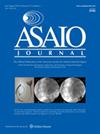Series Multiblood Pump Design With Dual Activation for Pediatric Patients With Heart Failure.
IF 3.1
3区 医学
Q2 ENGINEERING, BIOMEDICAL
引用次数: 0
Abstract
The translational development of pediatric ventricular assist devices (VADs) lags years behind adult device options, negatively impacting pediatric patient outcomes. To address this need, we are developing a novel, series-flow, double-blood pump VAD that integrates an axial and centrifugal pump into a single device. The axial pump is used for initial circulatory assistance in younger patients; then, an internal activation mechanism triggers the centrifugal pump to activate in line with the axial pump, providing additional pressure and flow to match pediatric patient growth cycles. Here, we focused on the design and improvement of the device flow paths through computational analysis and in vitro hydraulic testing of a prototype. We estimated pressure-flow generation, fluid scalar stresses, and blood damage levels. In vitro hydraulic tests correlated well with shear stress transport (SST) predictions, with an average deviation of 4.5% for the complex, combined flow path. All data followed expected pump performance trends. The device exceeded target levels for blood damage in the blade tip clearances, and this must be both investigated and addressed in the next design phase. These study findings establish a strong foundation for the future development of the Drexel Double-Dragon VAD.针对小儿心力衰竭患者的双启动系列多血流泵设计
儿科心室辅助设备(VAD)的转化开发落后于成人设备多年,对儿科患者的治疗效果产生了负面影响。为了满足这一需求,我们正在开发一种新型的串联流双血泵 VAD,它将轴向泵和离心泵集成到一个设备中。轴向泵用于年轻患者的初始循环辅助;然后,内部激活机制触发离心泵与轴向泵同步启动,提供额外的压力和流量,以配合儿科患者的生长周期。在这里,我们通过计算分析和原型的体外水力测试,重点研究了设备流路的设计和改进。我们估算了压力-流量产生、流体标量应力和血液损伤水平。体外水力测试与剪切应力传输(SST)预测结果有很好的相关性,复杂的组合流路的平均偏差为 4.5%。所有数据都符合预期的泵性能趋势。该装置的叶尖间隙超过了血液损伤的目标水平,这必须在下一个设计阶段进行调查和解决。这些研究结果为德雷塞尔双龙 VAD 的未来发展奠定了坚实的基础。
本文章由计算机程序翻译,如有差异,请以英文原文为准。
求助全文
约1分钟内获得全文
求助全文
来源期刊

ASAIO Journal
医学-工程:生物医学
CiteScore
6.60
自引率
7.10%
发文量
651
审稿时长
4-8 weeks
期刊介绍:
ASAIO Journal is in the forefront of artificial organ research and development. On the cutting edge of innovative technology, it features peer-reviewed articles of the highest quality that describe research, development, the most recent advances in the design of artificial organ devices and findings from initial testing. Bimonthly, the ASAIO Journal features state-of-the-art investigations, laboratory and clinical trials, and discussions and opinions from experts around the world.
The official publication of the American Society for Artificial Internal Organs.
 求助内容:
求助内容: 应助结果提醒方式:
应助结果提醒方式:


